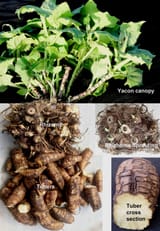Search Results
8/3/2025, 3:57:46 PM
>>512119138
A plant similar to the Sunchoke is the Yacon. The Yacon produces potato like tubers but prefers warmer temperatures and mild winters. It can grow in the UK. Again this is a plant that raiders and the unsuspecting might overlook.
https://www.youtube.com/watch?v=9fdqyKertME
>The yacón (Smallanthus sonchifolius) is a species of daisy traditionally grown in the northern and central Andes from Colombia to northern Argentina for its crisp, sweet-tasting, tuberous roots.[citation needed] Their texture and flavour are very similar to jícama, mainly differing in that yacón has some slightly sweet, resinous, and floral (similar to violet) undertones to its flavour, probably due to the presence of inulin, which produces the sweet taste of the roots of elecampane, as well.[citation needed] Another name for yacón is Peruvian ground apple, possibly from the French name of potato, pomme de terre (ground apple).
>Yacón can easily be grown in gardens in climates with only light freezes. It grows well in Kathmandu, Nepal, southern Australia (including Tasmania) and in New Zealand, where the climate is mild and the growing season long. The plant was introduced to Japan in the 1980s, and from there its cultivation spread to other Asian countries, notably South Korea, China, and the Philippines, and is now widely available in markets in those countries.
>The tubers can be eaten raw, boiled, dehydrated, roasted or processed into beverages, jams, syrup, vinegar, flour, chips and juice. If they are eaten fresh, they are sweet and crunchy.
A plant similar to the Sunchoke is the Yacon. The Yacon produces potato like tubers but prefers warmer temperatures and mild winters. It can grow in the UK. Again this is a plant that raiders and the unsuspecting might overlook.
https://www.youtube.com/watch?v=9fdqyKertME
>The yacón (Smallanthus sonchifolius) is a species of daisy traditionally grown in the northern and central Andes from Colombia to northern Argentina for its crisp, sweet-tasting, tuberous roots.[citation needed] Their texture and flavour are very similar to jícama, mainly differing in that yacón has some slightly sweet, resinous, and floral (similar to violet) undertones to its flavour, probably due to the presence of inulin, which produces the sweet taste of the roots of elecampane, as well.[citation needed] Another name for yacón is Peruvian ground apple, possibly from the French name of potato, pomme de terre (ground apple).
>Yacón can easily be grown in gardens in climates with only light freezes. It grows well in Kathmandu, Nepal, southern Australia (including Tasmania) and in New Zealand, where the climate is mild and the growing season long. The plant was introduced to Japan in the 1980s, and from there its cultivation spread to other Asian countries, notably South Korea, China, and the Philippines, and is now widely available in markets in those countries.
>The tubers can be eaten raw, boiled, dehydrated, roasted or processed into beverages, jams, syrup, vinegar, flour, chips and juice. If they are eaten fresh, they are sweet and crunchy.
Page 1
